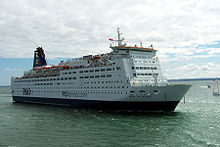This article has multiple issues. Please help improve it or discuss these issues on the talk page. (Learn how and when to remove these messages)
|
A cruiseferry is a ship that combines the features of a cruise ship and a Ro-Pax ferry. Many passengers travel with the ships for the cruise experience, staying only a few hours at the destination port or not leaving the ship at all, while others use the ships as means of transportation.

Cruiseferry traffic is mainly concentrated in the seas of Northern Europe, especially the Baltic Sea and the North Sea. However, similar ships traffic across the English Channel as well as the Irish Sea, Mediterranean and even on the North Atlantic. Cruiseferries also operate from India, China and Australia.
Baltic Sea cruiseferries
editIn the northern Baltic Sea, two major rival companies, Viking Line and Silja Line, have for decades competed on the routes between Turku and Helsinki in Finland and Sweden's capital Stockholm. Since the 1990s Tallink has also risen as a major company in the area, culminating with acquisition of Silja Line in 2006.
List of largest cruiseferries of their time
editThis section needs to be updated. (May 2023) |
The term "cruiseferry" did not come into use until the 1980s, although it has been retroactively applied to earlier ferries that have large cabin capabilities and public spaces in addition to their car- and passenger-carrying capacity.[citation needed]
List of cruiseferry operators
editÅland
editAustralia
editCanada
editCroatia
editDenmark
editEstonia
editFaroe Islands
editFinland
edit- Eckerö Line
- Silja Line (operated by Tallink)
- ( ) Viking Line
- Finnlines
- Wasa Line
France
editGreece
edit- ANEK Lines
- Blue Star Ferries
- Hellenic Seaways
- LANE Lines
- Levante Ferries
- Minoan Lines
- NEL Lines
- Superfast Ferries
- Ventouris Ferries
Hong Kong
edit- Genting Hong Kong (defunct)[1]
Ireland
editItaly
editMexico
editNorway
editPoland
editSpain
editSweden
editUnited Kingdom
edit- UK P&O Ferries
- UK NorthLink Ferries
- UK Condor Ferries
- UK Irish Ferries
- UK Stena Line
- UK Caledonian MacBrayne
Japan
editGallery
edit-
Pont-Aven, Brittany Ferries' flagship.
-
M/S Silja Europa, the largest cruiseferry in the world 1993–2001.
-
M/S Cinderella departing Helsinki.
-
M/S Color Fantasy, the largest cruiseferry in the world 2004–2007.
-
MS Cruise Roma in Civitavecchia, Italy.
-
MS Galaxy in Helsinki West Harbour.
-
MV Cap Finistère of Brittany Ferries sailing from Portsmouth International Port, UK for Bilbao, Spain.
See also
editReferences
edit- ^ Ngui, Yantoultra (2022). "How a Billionaire's Cruise Empire Imploded in Hong Kong". Bloomberg.com. Retrieved 2 November 2024 – via EBSCOhost.
- ^ "Travelscene boosts options in Cruiseferry programme". Travel Trade Gazette UK & Ireland. No. 2534. 2002. p. 63. Retrieved 2 November 2024 – via EBSCOhost.